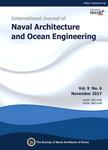版权所有:内蒙古大学图书馆 技术提供:维普资讯• 智图
内蒙古自治区呼和浩特市赛罕区大学西街235号 邮编: 010021

作者机构:Centre for Offshore Engineering and Safety Technology China University of Petroleum (East China) No.66 Changjiang West Road Qingdao China
出 版 物:《International Journal of Naval Architecture and Ocean Engineering》
年 卷 期:2019年第11卷第1期
页 面:22-32页
主 题:Offshore platform DEMATEL Bayesian network Accident Leakage Quantitative risk Dynamic BN Bayesian network BP British Petroleum CPT Conditional probability table D Sum of columns of matrix T DEMATEL Decision Making Trial and Evaluation Laboratory DQRA Dynamic quantitative risk assessment DRAM Dynamic risk assessment method ET Event tree f Cumulative frequency of failures FT Fault tree f ( x ) Prior probability f ( x | data ) Dynamic posterior probability GeNIe Graphical network interface g ( data |x) Likelihood acquired form the precursor data I Identity matrix M Normalized matrix QRA Quantitative risk assessment R Sum of rows of matrix T s Cumulative frequency of successes T Total relation matrix X Initial direct relation matrix
摘 要:On offshore platforms, oil and gas leaks are apt to be the initial events of major accidents that may result in significant loss of life and property damage. To prevent accidents induced by leakage, it is vital to perform a case-specific and accurate risk assessment. This paper presents an integrated method of Ddynamic Qquantitative Rrisk Aassessment (DQRA)—using the Decision Making Trial and Evaluation Laboratory (DEMATEL)-Bayesian Network (BN)—for evaluation of the system vulnerabilities and prediction of the occurrence probabilities of accidents induced by leakage. In the method, three-level indicators are established to identify factors, events, and subsystems that may lead to leakage, fire, and explosion. The critical indicators that directly influence the evolution of risk are identified using DEMATEL. Then, a sequential model is developed to describe the escalation of initial events using an Event Tree (ET), which is converted into a BN to calculate the posterior probabilities of indicators. Using the newly introduced accident precursor data, the failure probabilities of safety barriers and basic factors, and the occurrence probabilities of different consequences can be updated using the BN. The proposed method overcomes the limitations of traditional methods that cannot effectively utilize the operational data of platforms. This work shows trends of accident risks over time and provides useful information for risk control of floating marine platforms.